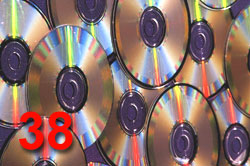
Timeline for
Broadcasting
In this module we'll summarize the history of broadcasting in terms of dates and major events.
|
Timeline for
In this module we'll summarize the history of broadcasting in terms of dates and major events. |
|
1871-73 |
The door to electromagnetism, the foundation of all of broadcasting, is opened by the theories of Michael Faraday and James Clerk-Maxwell. |
|
1884 |
Paul Nipkow devises a scanning disc television system. |
|
1886 |
Henrich Hertz experiments with electromagnetic waves. |
|
1892-94 |
Voice audio are transduced into electrical energy by Nathan Stubbelfield; Marconi transmits electromagnetic waves, the precursor of radio. |
|
1901 |
|
|
1904-06 |
J. Ambrose Fleming patents the Fleming vacuum tube "valve"; Lee deForest builds on the concept and introduces the audion amplifier tube . |
|
1906 |
H.C. Dunwoody invents crystal radio receiver. In the same year, 27 nations adopt wireless (radio) regulations at International Radiotelegraph Conference. |
|
1910 |
The U.S. issues the Wireless Ship Act. |
|
1912 |
Radio becomes a household name when it's used to aid rescue efforts as the Titanic, the "unsinkable" luxury cruise liner, sinks. The Radio Act of 1912 goes into effect. |
|
1914-18 |
Radio is extensively used to aid World War I effort. |
|
1919-20 |
9XM radio (later WHA) at the University of Wisconsin, Madison, signs on. KDKA in Pittsburgh, PA is licensed and begins regular programming . |
|
1922 |
"Toll" (commercial) broadcasting starts at WEAF, in New York. |
|
1923 |
V. K. Zworkin patents the iconoscope TV imaging tube . |
|
1927 |
U.S. Radio Act of 1927 is signed forming the Federal Radio Commission. |
|
1930 |
Philo T. Farnsworth receives a patent for television . |
|
1933 |
Closed-circuit TV educational television starts at State University of Iowa . |
|
1933 |
Edwin Armstrong demonstrates FM radio. |
|
1934 |
As part off the Communications Act of 1934, the Federal Communications Commission is formed to govern U.S. broadcasting . |
|
1939 |
Television is introduced at the U.S. World's Fair . |
|
1942 |
FCC authorizes 525-line, black and white TV in U.S. |
|
1947 |
The transistor is invented at Bell Laboratories leading to small, efficient electronic circuits . |
|
1948 |
Cable TV (CATV) is introduced in Pennsylvania and Oregon. |
|
1953 |
KUHT becomes first educational TV station. |
|
1953 |
|
|
1956 |
Ampex demonstrates the first practical videotape recorder in Redwood City, CA . |
|
1963 |
The Telstar satellite relays live TV pictures across the Atlantic. |
|
1977 |
Fiber optic technology introduced that greatly expands point-to-point audio and video transmissions . |
|
1983 |
Direct satellite broadcasts to homes begin. |
|
1984 |
FCC approves TV stereo system . |
|
1993 |
FCC expands AM radio band to allow more stations |
|
1995 |
Internet radio and TV start . |
|
1996 |
Telecommunications bill deregulates license renewal and station ownership. |
|
1999 |
Digital (including wide-screen HDTV) television broadcasting starts in the U.S. |
|
2005 |
More than 1,000 U.S. digital TV stations are on the air and television enjoys it's first major technological change in decades. Consumers start buying HDTV sets in significant numbers. |
|
To next module To index © 1996 - 2005, All Rights Reserved.
|